
Kensington High Street is the main shopping street in Kensington, London, England. The area is identified in the London Plan as one of 35 major centres in Greater London.

Queen Victoria Village, generally known as QV Melbourne or just QV, is a precinct in the Melbourne central business district, Victoria, Australia. Covering the city block bounded by Lonsdale, Little Lonsdale, Swanston, and Russell Streets, and located directly opposite the State Library of Victoria and Melbourne Central, QV comprises a large shopping centre, a central plaza, an underground food court, Melbourne central city's first full-size supermarket and apartment buildings.

The Prudential Tower, also known as the Prudential Building or, colloquially, The Pru, is an international style skyscraper in Boston, Massachusetts. The building, a part of the Prudential Center complex, currently stands as the 2nd-tallest building in Boston, behind 200 Clarendon Street, formerly the John Hancock Tower. The Prudential Tower was designed by Charles Luckman and Associates for Prudential Insurance. Completed in 1964, the building is 749 feet (228 m) tall, with 52 floors, and is tied with others as the 114th-tallest in the United States. It contains 1.2 million sq ft (110,000 m2) of commercial and retail space. Including its radio mast, the tower's pinnacle height reaches 907 feet (276 m).

Fenchurch Street is a street in London, England, linking Aldgate at its eastern end with Lombard Street and Gracechurch Street in the west. It is a well-known thoroughfare in the City of London financial district and is the site of many corporate offices and headquarters. The name "Fenchurch" means "church in the fenny or marshy ground" and presumably refers to St Gabriel Fenchurch, which stood at the junction of Fenchurch Street and Cullum Street until it was destroyed by the Great Fire.

Edgbaston House was a highrise commercial building in Duchess Place, Birmingham. It was built by Laing Development Co Ltd. and the consulting engineers were Ove Arup. Construction cost £1,720,000. It was the result of work by Calthorpe Estates to attract businesses to the Hagley Road and Five Ways by promoting the construction of office blocks there. It is part of the Duchess Place estate which consists of office blocks totalling 200,000 sq ft (19,000 m2). They are owned by the Kenmore Group, who acquired the estate from Chelsfield.

122 Leadenhall Street, which is also known as the Leadenhall Building, is a 225-metre-tall (738 ft) skyscraper in central London. It opened in July 2014 and was designed by the Rogers Stirk Harbour + Partners; it is known informally as The Cheesegrater because of its distinctive wedge shape, similar to that of the kitchen utensil of the same name. It is one of numerous tall buildings recently completed or under construction in the City of London financial district, including 20 Fenchurch Street, 22 Bishopsgate and The Scalpel.
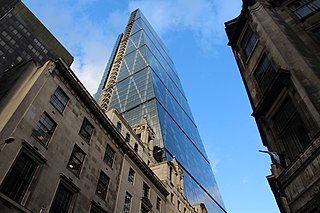
Leadenhall Street is a street in the City of London. It is about 1⁄3-mile-long (0.54 km) and links Cornhill in the west to Aldgate in the east. It was formerly the start of the A11 road from London to Norwich, but that route now starts further east at Aldgate.

Land Securities Group plc, trading as Landsec, is the largest commercial property development and investment company in the United Kingdom. The firm became a real estate investment trust (REIT) when REITs were introduced in the United Kingdom in January 2007. It is headquartered in London, England, and traded on the London Stock Exchange, and is a constituent of the FTSE 100 Index.
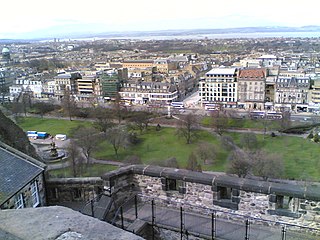
The New Town is a central area of Edinburgh, the capital of Scotland. It was built in stages between 1767 and around 1850, and retains much of its original neo-classical and Georgian period architecture. Its best known street is Princes Street, facing Edinburgh Castle and the Old Town across the geological depression of the former Nor Loch. Together with the West End, the New Town was designated a UNESCO World Heritage Site alongside the Old Town in 1995. The area is also famed for the New Town Gardens, a heritage designation since March 2001.
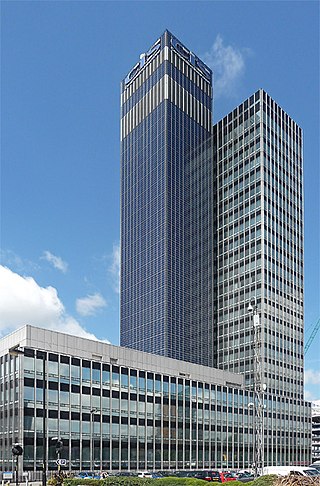
The CIS Tower is a high-rise office building on Miller Street in Manchester, England. Designed for the Co-operative Insurance Society (CIS) by architects Gordon Tait and G. S. Hay, the building was completed in 1962 and rises to 118 m (387 ft) in height. As of February 2024, the Grade II listed building is Greater Manchester's 12th-tallest building and the tallest office building in the United Kingdom outside London. The tower remained as built for over 40 years, until maintenance issues on the service tower required an extensive renovation, which included covering its façade in photovoltaic panels.

Mincing Lane is a short one-way street in the City of London linking Fenchurch Street to Great Tower Street. In the late 19th century it was the world's leading centre for tea and spice trading.
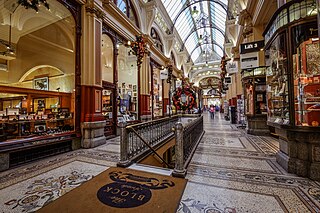
The Block Arcade is an historic shopping arcade in the central business district of Melbourne, Victoria, Australia. Constructed between 1891 and 1893, it is considered one of the late Victorian era's finest shopping arcades and ranks among Melbourne's most popular tourist attractions.
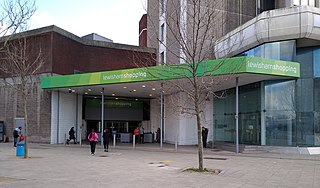
Lewisham Shopping Centre, formerly Riverdale Centre, is a shopping mall located in Lewisham, London, England. The centre is the major shopping centre in the London Borough of Lewisham. Also part of the complex is the Lewisham House office tower, formerly occupied by Citibank. There are proposals to convert this building to flats.

20 Fenchurch Street is a commercial skyscraper in London that takes its name from its address on Fenchurch Street, in the historic City of London financial district. It has been nicknamed "The Walkie-Talkie" because of its distinctive shape, said to resemble a walkie-talkie handset. Construction was completed in spring 2014, and the three-floor "sky garden" was opened in January 2015. The 38-storey building is 160 m (525 ft) tall. Since July 2017, the building has been owned by Lee Kum Kee Groups.
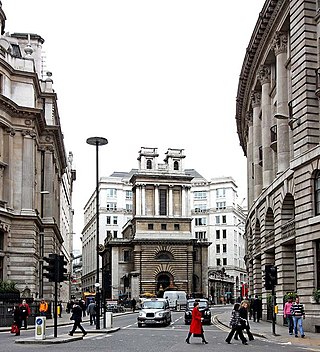
Lombard Street is a street notable for its connections with the City of London's merchant, banking and insurance industries, stretching back to medieval times.

Plantation Place South is an office building in the City of London. It consists of nine floors and forms part of a complex consisting of the larger 30 Fenchurch Street to the north. The building was designed by the Arup Associates architects' group. Plantation Place South was first proposed as a new area of office development in 2001 and construction work began in 2002; it was completed and opened two years later.

Mark Lane is a street in the City of London linking Great Tower Street and Fenchurch Street. It gave its name to the nearby Mark Lane tube station, which was opened in 1884, renamed Tower Hill in 1964, and closed three years later. For some 240 years, Mark Lane was known for the corn exchange ; it occupied a series of properties on the east side of the southern end of the street.

The East India Arms is a pub in the City of London. The building is located on Fenchurch Street near the place where the East India Company had its headquarters.

Chelmer Police College is a heritage-listed former police barracks at 17 Laurel Avenue, Chelmer, City of Brisbane, Queensland, Australia. It was built from 1900 to 1970. It is also known as 10 WRAAC Barracks, The Lady Wilson Red Cross Convalescent Home, and Waterton. It was added to the Queensland Heritage Register on 1 October 2003.
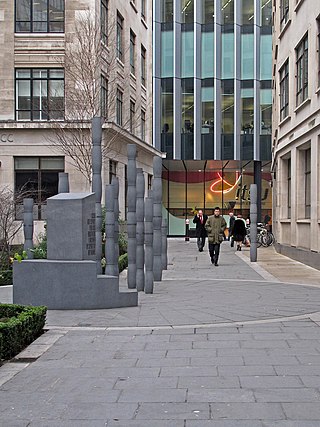
Fen Court is a short pedestrian passageway in the City of London, England, linking Fenchurch Street to Fenchurch Avenue.





















